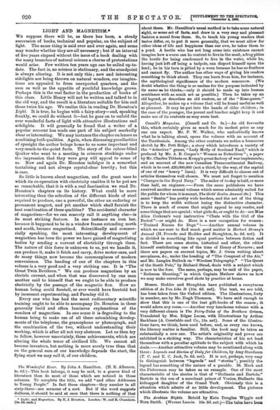LIGHT AND MAGNETISM.*
WE suppose there will be, as there has been, a steady succession of books, technical and popular, on the subject of light. The same thing is said over and over again, and some may wonder whether they are all necessary ; but if an interval of five years elapsed without the issue of a book dealing with the many branches of natural science a chorus of protestations would arise. Few written ten years ago can be called up-to- date. The fact is, no science is stationary, and the standpoint is always altering. It is not only this ; new and interesting sidelights are being thrown on natural wonders, our imagina- tions are appealed to from unexpected quarters, and the sum as well as the appetite of youthful knowledge grows. Perhaps this is the real factor in the production of books of thi3 class. Little Henry will not be written and talked to in the old way, and the result is a literature suitable for him and those twice his age. We realise this in reading Dr. Houston's Light. It is true, he begins with a fairy-story—and, speaking frankly, we could do without it—but he goes on to unfold the ever wonderful facts of light with attractive illustrations and sidelights. It will generally be found that a writer of a popular account has made one part of his subject markedly clear or interesting. We may instance the chapter on lenses as combining both qualities. Again, when discussing peculiarities of eyesight the author brings home to ns some important and very-much-to-the-point facts. The story of the colour-blind Quaker who went to a meeting in crimson stockings under the impression that they were grey will appeal to some of us. Now and again Dr. Houston indulges in a somewhat tantalising and not always crystal-clear brevity ; but this is rare.
So little is known about magnetism, and the great uses to which its co-operation with electricity enables it to be put are so remarkable, that it is with a real fascination we read Dr. Houston's chapters on its history. What could be more interesting than the selection of the different kinds of steel required to produce, one a powerful, the other an enduring or permanent magnet, and yet another which shall furnish the best combination of these qualities ? The accidental character of magnetism—for we can scarcely call it anything else—is its most striking feature. In one instance an iron bar, because it happened to be in a window frame extending north and south, became magnetised. Scientifically and commer- cially speaking, the most interesting development of magnetism has been the power we have gained of magnetising bodies by sending a current of electricity through them. The nature of this force is unknown to us, yet we handle it can produce it, make it fetch and carry, drive motor-cars, and do many things now become the commonplaces of modern convenience. The heading of one of the chapters in this volume is a very good and a very striking one. It is "The Great Twin Brethren." We can produce magnetism by an electric current, and when that was discovered by one man another said to himself that we ought to be able to produce electricity by the passage of the magnetic flux. How no human being could foretell, or ever would have foretold but by incessant experimenting, and Faraday did it.
Every one who has had the most rudimentary scientific training ought to be able to accompany Dr. Houston in these generally lucid and often luminous explanations of the wonders of magnetism. In one sense it is degrading to the human being to make use of all these astonishing develop- ments of the telephone, the gramophone or phonograph, and the combination of the two, without understanding their working, which is after all not very abstruse. Let us then try to follow, however uncertainly, these achievements, which are altering the whole tenor of civilised life. We cannot all become inventors, but nothing is more surely true than that on the general sum of our knowledge depends the start, the flying start we may call it, of our children.






































































 Previous page
Previous page